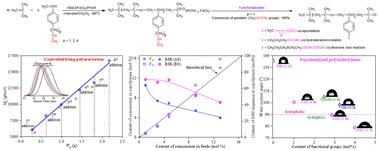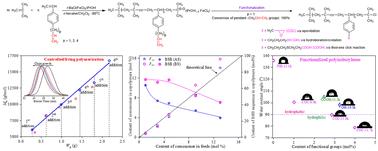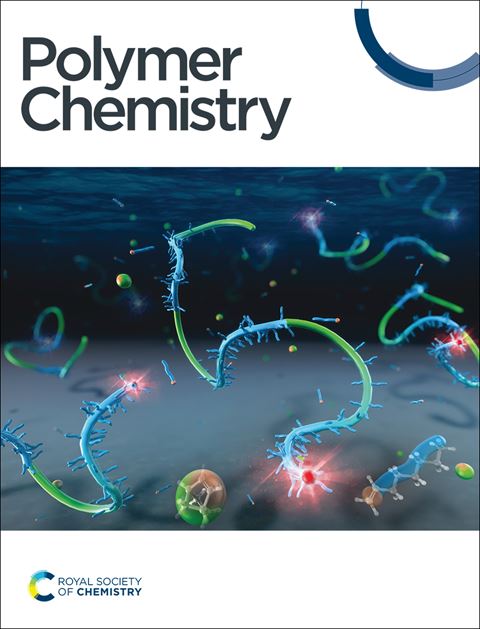通过阳离子聚合高效合成具有悬垂乙烯基的无规异丁烯/烯基苯乙烯共聚物,实现多功能功能化
IF 3.9
2区 化学
Q2 POLYMER SCIENCE
引用次数: 0
摘要
采用t- bul /FeCl3/iPrOH引发体系,在- 80°C的正己烷/CH2Cl2 (6/4 v/v)中,对-(3-丁基)-苯乙烯(BS)和对-(5-己基)-苯乙烯(HS)中进行了异丁烯(IB)与烯基苯乙烯(AS)、对-(3-丁基)-苯乙烯(BS)的可控/活性阳离子共聚反应。在不交联的情况下,可以得到IB与AS、BS或HS的无规共聚物,随着AS投料比的增加,共聚物中AS单元的含量从0.71 mol%线性增加到14.23 mol%。采用Fineman-Ross法测定单体反应比r分别为rAS = 4.16和rIB = 1.66。用全单体In (AMI)和增量单体加成(IMA)技术在−80℃下证实了IB与AS阳离子共聚的活性。共聚物的产率、Mn和Mw/Mn随聚合温度(Tp)的升高而降低,表观活化能(Ea)与Tp有关。上述聚(IB-co-AS)共聚物中悬垂的乙烯基可以通过硼氢化/氧化、巯基咔嗒反应或环氧化反应完全转化为羟基、羧基或环氧基。引入羟基、羧基或环氧悬垂基团的功能化共聚物的膜表面亲水性可以得到改善,当环氧基团的摩尔含量从0增加到3.99%时,含环氧悬垂基团的聚(lb -co- as)的水接触角(WCA)从134.9°降低到78.7°。因此,含有大量垂链乙烯基和多极性基团的无规异丁烯/烯基苯乙烯共聚物在高活性弹性体、粘合剂和无机填料的两亲性材料中具有潜在的应用前景。本文章由计算机程序翻译,如有差异,请以英文原文为准。


Highly efficient synthesis of random isobutylene/alkenyl styrene copolymers with pendant vinyl groups via cationic polymerization for versatile functionalization†
The controlled/living cationic copolymerizations of isobutylene (IB) with alkenyl styrenes including 4-allylstyrene (AS), p-(3-butenyl)-styrene (BS) and p-(5-hexenyl)-styrene (HS) were carried out in n-hexane/CH2Cl2 (6/4 v/v) at −80 °C using a t-BuCl/FeCl3/iPrOH initiating system. The random copolymers of IB with AS, BS or HS could be obtained without crosslinking and the contents of AS units in the copolymers linearly increased from 0.71 mol% to 14.23 mol% with an increase in the feed ratio of AS. The monomer reactivity ratios (r) were determined to be rAS = 4.16 and rIB = 1.66 by the Fineman–Ross method, respectively. The livingness of cationic copolymerization of IB with AS was confirmed by All Monomer In (AMI) and Incremental Monomer Addition (IMA) techniques at −80 °C. The yields, Mn and Mw/Mn of the resulting copolymers decreased with increasing polymerization temperature (Tp) and the apparent activation energy (Ea) depended on Tp. The pendant vinyl groups in the above poly(IB-co-AS) copolymers can be completely converted into hydroxyl groups, carboxyl groups or epoxy groups via hydroboration/oxidation, thiol–ene click reaction or epoxidation. The hydrophilicity on the film surface of functionalized copolymers with hydroxyl, carboxyl or epoxy pendant groups could be improved by introduction of the functional groups and the water contact angle (WCA) of poly(IB-co-AS) with epoxy pendant groups decreased from 134.9° to 78.7° upon increasing the molar content of epoxy groups from 0 to 3.99%. Therefore, the random isobutylene/alkenyl styrene copolymers containing plentiful pendant vinyl groups and versatile polar groups would have potential applications in highly reactive elastomers, adhesives and amphiphilic materials with inorganic fillers.
求助全文
通过发布文献求助,成功后即可免费获取论文全文。
去求助
来源期刊

Polymer Chemistry
POLYMER SCIENCE-
CiteScore
8.60
自引率
8.70%
发文量
535
审稿时长
1.7 months
期刊介绍:
Polymer Chemistry welcomes submissions in all areas of polymer science that have a strong focus on macromolecular chemistry. Manuscripts may cover a broad range of fields, yet no direct application focus is required.
 求助内容:
求助内容: 应助结果提醒方式:
应助结果提醒方式:


